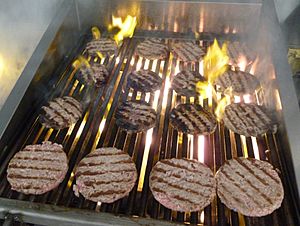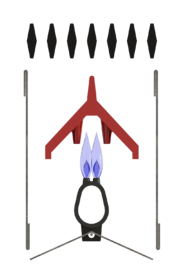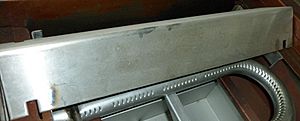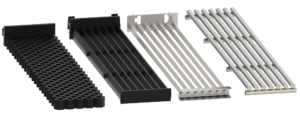Charbroiler facts for kids
Quick facts for kids Charbroiler |
|
|---|---|
| Classification | Cooking equipment |
| Industry | Various |
| Application | Cooking |
| Fuel source | Natural gas, Propane |
A charbroiler is a popular cooking tool. You might also hear it called a chargrill or just a broiler. It has a set of metal grates or ribs that get very hot. People use charbroilers in their homes, like a BBQ grill, and in big restaurants. They're great for cooking all kinds of food!
The heat source is almost always right under the cooking surface. If it uses gas, it's called an "under-fired broiler." Most charbroilers have long, evenly spaced metal bars over a chamber with many burners. These burners might have special parts like deflectors or briquettes to help spread the heat.
The words "charbroiling," "broiling," and "grilling" are often used to mean the same thing. However, depending on the equipment, there can be small differences in how the food cooks. Grilling means cooking food on a grated surface to lock in flavors and give it a smoky taste.
Contents
How Do Charbroilers Work?
Charbroilers can be stand-alone machines on a counter or part of a bigger kitchen setup, like a restaurant stove. They usually come in different sizes, often starting from about 2 feet wide.
A typical commercial charbroiler has three main parts:
- Burners: These create the heat.
- Radiants: These spread the heat evenly.
- Grates: This is the cooking surface where the food sits.
The way these parts work together changes how well the charbroiler cooks. Other features, like special plates under the burners, can also improve how it works.
Charbroilers cook food using three main ways heat moves:
- Convection: Heat moves through the air.
- Conduction: Heat moves when things touch (like food on the hot grates).
- Radiation: Heat moves as invisible waves (like from a hot lamp).
How well a charbroiler works depends on how fast it heats up, if the temperature stays even, and how much food it can cook per hour. Some charbroilers are designed to cook mostly with infrared heat, which has special benefits for the food.
Why Do Charbroilers Have Hot Spots?
Charbroilers are not always known for having perfectly even cooking temperatures. The temperature can vary a lot across the surface. This happens because the burners often create a "heat plume." This means the heat tends to gather in the center, leaving the edges a bit cooler.
You can often see these hot spots on the grates themselves. Areas that get super hot (over 700°F or 370°C) will burn off any oils left from cooking, leaving white ash. This white ash shows you where the hottest parts are.
Building a Charbroiler
All charbroilers are built to do the same basic job: provide a large, flat, hot, ribbed surface to cook food with dry heat.
When you charbroil, food cooks on a grated surface. This helps to seal in flavors and gives the food a slightly smoky taste. Charbroiling often exposes food to temperatures over 500°F (260°C). Grilled meat gets a special "roast" smell and taste from a chemical process called the Maillard reaction. This reaction only happens when food reaches temperatures above 310°F (155°C).
When you charbroil foods, especially meats, they release fats and oils. These can vaporize and burn when they hit the super hot surfaces of the charbroiler. The smoke and flavors from this burning then get into the food, giving it that distinct "charbroiled" taste.
Burners: The Heat Makers
The burners in a charbroiler create heat. Most of this heat then goes to the radiant element above it, which helps spread it out.
Radiants: Spreading the Heat
The radiant part of a charbroiler is designed to spread, soak up, and then send out the heat from the burner. It's usually shaped like a tent and made from cast iron or sheet metal.
What About Lava Rock or Briquettes?
Sometimes, lava rock, ceramic bricks, or even charcoal are used as a radiant. These materials also help spread the heat from the burners. They do a good job, but sometimes the heat might not be perfectly even.
Grates: The Cooking Surface
The grate is the actual cooking surface of a charbroiler. It's also called the cooking grid. Grates come in many shapes and materials to fit different cooking needs. They usually have ribs that run from front to back, often with extra support bars. Cast iron is the most common material for grates, but steel rods are also used.
The grates are what create those cool sear marks (or "branding") on charbroiled foods. These marks are often a key part of how a restaurant's food looks. Good branding marks on meat should be a caramel color, like a cola, not too dark, which would mean they're burned.
Using a Charbroiler
Most charbroilers are usually run on the "fully ON" setting. This is because it's hard to control the exact surface temperature with the limited range of the valves. Also, because of the hot spots, chefs sometimes tilt the grates (if the design allows) to move food away from the super hot areas.
Charbroilers use a lot of energy. A small unit with four burners can use a lot of gas per hour. Larger units with more burners use even more. This means they can be quite expensive to run, depending on how long they are used each day.
Images for kids










